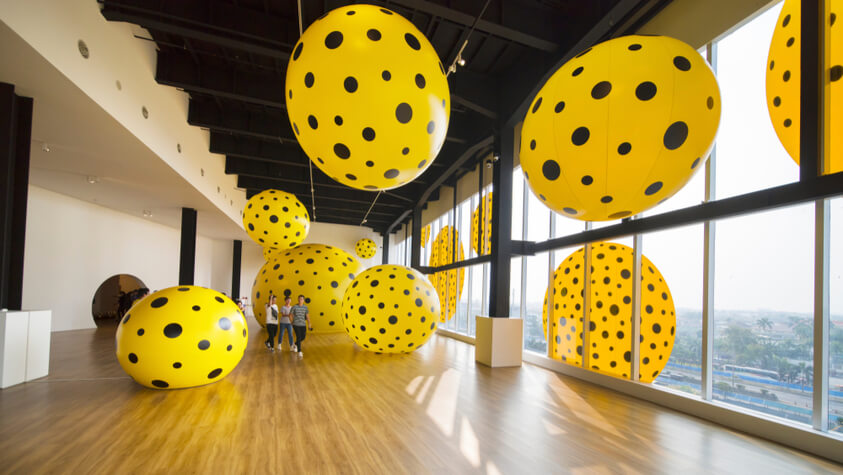By TACP Staff on July 06, 2021

A museum exhibition designer is the developer of plans which ultimately lead to the construction of public displays for educational and enjoyment purposes. Activities inherent to the career include; concept and design development; schematic design; construction document development; fabrication and installation. Museum exhibition designers make important contributions to culture and history; as well as provide valuable services to the communities in which they work and live.
While walking through a museum, we’ll often encounter stunning and displays that are meant to show a certain artifact or piece of artwork in the most attractive way possible. These visually stimulating displays often invoke awe and wonder in children and adults alike.
These wondrous displays are referred to as museum exhibits. They can be found in all types of museums, including art museums, history museums, and science museums. Museum exhibits are set up and arranged to be both attractive and educational. Designing a museum exhibit, therefore, takes a good deal of careful planning and hard work. The exhibits in a museum are typically set up so that they are placed and displayed as naturally as possible. They must also be designed with a museum’s available space and budget in mind.
Some exhibits are designed to be permanent fixtures in a museum, while others are only temporary. Some may be designed to allow hands-on interaction, while others must be protected from curious museum-goers.
In many instances, the careful planning and set up of museum exhibits is left to the careful hands of museum exhibit designers.
A museum exhibit designer is responsible for the overall design and planning of museum exhibits. These professionals can work in all types of museums and galleries, from large history museums to intimate art galleries. In general, a museum exhibit designer will often have a number of different duties and responsibilities.
The size of a museum, however, will often be a factor in what a museum exhibit designer’s responsibilities are. For instance, museum exhibit designers in small museums will often where many hats; they might also be the museum curators, archivists, member service associates, and even the janitors. Exhibition designers in larger museums, however, are often just responsible for the actual planning and design of the exhibits.
Planning a museum exhibit may look easy, but it generally requires more than simply scattering things about. The first thing that a museum exhibit designer must do is assess the available space and budget he has to work with.
He can then try to visualize how the items in the exhibit would look best. Several things should be kept in mind during the initial planning stages of a museum exhibit. Some of the things that exhibit designers may need to consider include the intended audience of the exhibit and whether or not museum goers will need seating around the exhibit. Historic exhibits are also often arranged to be as authentic as possible, so some research might also be involved. Different types of lighting should also be considered, in order to help set the mood for the exhibit and make it easily visible. Depending on the type of the exhibit, various props can also be used to add to the atmosphere.
Once a museum exhibit designer has a good idea of what the exhibit will look like, he will then usually create a visual representation of it. This is often done by sketching the future exhibit, or it can be done using sophisticated design software.
Setting up the exhibit is a museum exhibit designer’s next step. Depending on the size and budget of the museum, an exhibit designer may or may not have help with this step. Larger museums with higher budgets, for instance, will often hire museum technicians to help with this stage. In this case, it is often the responsibility of the museum exhibit designer to oversee all of the workers who are setting up the exhibit. Smaller museums usually have smaller budgets, on the other hand, so it may be the responsibility of the exhibit designer alone to set of each exhibit.
In many ways, a museum exhibit designer is a jack-of-all-trades. He will need to have several different skills in order to have a successful exhibit design career. For example, he must be knowledgeable in art, history, design, lighting, and possibly carpentry.
A degree in museum studies is often the best way to start a museum exhibit design career. Because only a handful of colleges and universities offer bachelor degree programs in this students should focus on earning a degree in art or art history instead. Future museum exhibit designers should consider taking several courses in art history as well as courses in the various forms of art, such as painting and sculpting. Courses in set design are also recommended as well as courses in industrial design and CAD.
After earning a bachelor’s degree, an aspiring museum exhibit designer should also consider earning a Master’s degree in museum studies. This advanced degree will often open more museum doors to graduates, and in fact, many museums actually require it.
Taking their education one step further and earning a doctorate in museum studies can also help a museum exhibit designer further his career even more. Professionals who hold these degrees are often considered for higher museum positions, such as museum curator positions.
Consider these related careers in Art and Art Studies.

The Art Career Project is a trusted resource for emerging and professional artists.